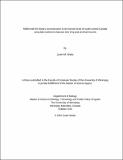Millennial fire history reconstruction in the boreal forest of south-central Canada using lake-sediment charcoal, tree-ring and archival records

View Open
Metadata
Show full item recordAuthor
Waito, Justin M.
Date
2016Citation
Waito, Justin M. Millennial fire history reconstruction in the boreal forest of south-central Canada using lake-sediment charcoal, tree-ring and archival records; A thesis submitted to the Faculty of Graduate Studies of the University of Winnipeg in partial fulfillment of the Master of Science degree. Winnipeg, Manitoba, Canada: University of Winnipeg, October 2016.
Abstract
The Canadian boreal forest has been developing since the end of the last glaciation approximately 10,000 years ago. During this time, fire has modified the development of the forest by altering species distribution, stand structure and forest regeneration. With future climate changes, the fire frequency and annual area burned (AAB) are expected to increase with increasing temperatures. It remains unclear what effect this increase in fire frequency will have on the forest. Current projections of future fire are often based on relatively short environmental records and longer records are needed to capture variability in fire occurrence over millennia. In this study, a multi-millennial fire history was reconstructed for eight lakes from the Lake of the Woods Ecoregion (LWE) within the boreal forest of central North America using a combination of archival, tree-ring and lake sediment charcoal records. The archival record provided fire dates and area burned information for the period 1920 to 2010. A tree-ring fire history reconstruction was developed around eight lakes for the period 1690-2010 from stand initiation dates and fire scars. The fire history reconstruction was extended through lake sediment charcoal records obtained from overlapping sediment cores collected from eight lakes. For each lake, the sediment fire history reconstruction was obtained from macroscopic charcoal particles with an area >150 micrometers. Calculation of the Charcoal Accumulation Rate (CHAR) and subsequent peak analysis of the CHAR record allowed for the examination of changes in fire regime dating back to 2500 BP (500 BCE).
The archival and tree-ring records revealed recent large fires (>200 ha) in 1948, 1980 and 1989. An additional 17 fires were identified by the fire-scar record. Fire events in 1805, 1840, 1863, and the 1890’s were identified in numerous locations around multiple lakes suggesting that they were of large extents. In accordance with the tree-ring record, the CHAR peak record generally identified the major fires, with identification becoming less accurate for smaller fires and those in close succession. The CHAR record also tended to lag behind fires identified from tree-ring records by several decades. Within the LWE, the long-term charcoal record revealed that CHAR was higher for each lake in the earlier portion of the record followed by a progressive decrease towards the more recent record. Multi-millennial fluctuations in CHAR suggested that modern temperature increases could lead to higher fire frequency than that observed over the last two millennia.
